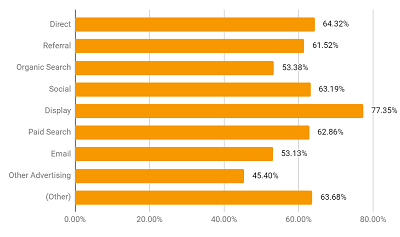 Friday, April 26, 2024
Friday, April 26, 2024  Friday, April 26, 2024
Friday, April 26, 2024 
Among web analytic statistics, the bounce rate is one of the metrics most often overlooked by marketers. A bounce rate is the percentage of single-page visitors to your website who leave your website quickly after arriving. Some advanced systems also use visit duration to calculate bounce rate which treats visitors as bounces if they stay on the site for less than 5 seconds.
Bounce rate can also be defined as a negative statistic. It measures how engaging your website is to your visitors and how well it relates to them. It also measures how effective and ‘sticky’ your landing page is when it’s used with a campaign. Lack of relevancy is a major cause of bounces; however, the problem can also be caused by where you acquire your traffic or the design of your landing page. Let’s look at a few things you can do to reduce bounce rates (remember: the lower, the better).
Before you start improving your bounce rate, it’s important to understand how your website is currently performing. To do this, you’ll need to take a look at Google Analytics or if you have a marketing software, like ActiveConversion, that should also list your bounce rate. If you don’t have Google Analytics or marketing software, your first step will be to install a tool onto your site and start tracking website visitor data. You can create a Google Analytics account for free at https://analytics.google.com/.
Once you know your bounce rate, you can compare your website to your industry’s standard bounce rate. A bounce rate is never going to come close to 0%, so there’s no point aiming for that. For business/industrial websites, the average bounce rate in 2018 was 58.68% (based on data from Google Analytics Benchmark Reports). Above, you can find the average bounce rate for business/industrial websites by traffic source.
Many marketers use social media as part of their marketing campaigns. However, many of these referrers are of low-value. These visitors aren’t “looking” when they arrive at your website, so they tend to leave immediately. You don’t have to worry too much about bounce rates from these traffic sources, but you should still be aware of the rate.
High bounce rates from other sources may be a bigger problem, particularly if the source is a PPC (pay-per-click) campaign. If you’re paying for a website visitor, you definitely don’t want them bouncing off your website as soon as they arrive.
Discover which sources are causing you the most significant bounce rate problems and then you can form a plan to solve the issue.
Not “giving the banana to the monkey” is a classic conversion problem. When people arrive at your website and can’t find what they want, most will not take the time to hunt around. Instead, they’ll leave and visit the next listing that appears in their Google search.
You only have a few seconds to let the visitors know that they are in the right place, so “give the banana to the monkey.”
If you’re using a PPC campaign, you should have targeted landing pages that your ad will direct visitors to. This landing page should directly correlate to the content of the ad. If your ad references a specific product or service, then that better be featured front and centre on your landing page.
For people coming to your main home page (not a landing page), it’s also important that they’re able to find what they’re looking for quickly. Have your contact information or a “contact us” button clearly displayed on the page, have a headline that gives an easy to understand overview of what you do, and have clear menu options that link to pages with additional information on topics of interest.
Pay-per-click search and display campaigns generally have some of the worst bounce rates. Often times, this can be mitigated with a well-designed landing page that follows some simple best practices.
Overall, just try and remember that you need to capture the lead’s interest within the first few seconds; so really ask yourself if your landing page is going to do that.
One reason people bounce off your website quickly is that they’re not actually in your target market. They may have been looking for something else and stumbled across your website in the process. Say for example, that you sell industrial flow control valves and you bid on the word “valves” in GoogleAds. Chances are that you will get a lot of unqualified traffic that quickly bounces off your site because they were looking for a different kind of valve.
A well-targeted keyword will bring well-targeted traffic. There may be fewer people that search for that word, but at least the people that do will be qualified.
By using landing pages, well-targeted ads and keywords, and giving leads what they’re looking for as soon as they hit your website, you’re certain to see at least some improvement in your bounce rate. Good luck!
ActiveConversion is the leading industrial sales and marketing solution provider across North America. We have been making sales and marketing work for business-to-business since 2007.
Construction Links Network powered by ActiveConversion brings a revolutionary next-gen online marketing technology to the construction, building and design industry through the peer-to-peer news sharing platform, digital & branding packages and memberships.